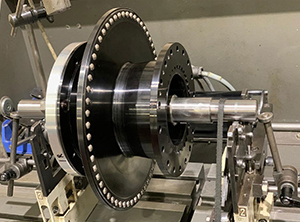Correcting unbalance in machinery
12 February 2024
Dynamic balancing involves the adjustment of a rotor’s balance by adding or removing weight.
 Firstly, we need to determine the components’ unbalance. We calculate this whilst the rotor is rotating at a predetermined speed. The information from this process gives insight into the amount of weight required to counterbalance areas that are either too light or too heavy. A component is only in balance once the centrifugal force produced by the rotation speed is within the required tolerance.
Firstly, we need to determine the components’ unbalance. We calculate this whilst the rotor is rotating at a predetermined speed. The information from this process gives insight into the amount of weight required to counterbalance areas that are either too light or too heavy. A component is only in balance once the centrifugal force produced by the rotation speed is within the required tolerance.What causes unbalance?
• Machining error
• Design error
• Porosity of the material
• Wear and tear
• Bent shaft
• Build-up and deposits
• Thermal distortion
What are the effects of unbalance?
• Excessive vibration
• Premature bearing/machine failure
• Excessive noise
• Structural damage due to vibration
• Risk to the safety of personnel
Once we are able to identify the amount of unbalance, we can correct it by adding weight to the opposite side of the ‘heavy spot’. Alternatively, we can remove weight from the heavy spot itself. Adding balance weight is usually for more commercial fans and rolls etc. However, the removal of weight using the methods below are primarily for precision machine components i.e. aerospace.
How can you add balance weight?
• Fastening using bolts
• Welding
• Using adhesive or balance putty
How can you remove balance/unbalanced weight?
• Drilling at the designated area(s)
• Grinding using various hand tools
• Milling through radial milling of the designated balance lands
• Eccentric turning, AKA offset machining method (shown in the video below), where the heaviest position is offset at the required amount so it can be turned to achieve balance
Get in touch to ensure your rotating machinery is operating as efficently as possible.
Other Press Releases By This Company
- 21/03/2024 - Dynamic Balancing: An interview with our Production Manager
- 15/08/2023 - The benefits of Machine Condition Monitoring for rotating machinery
- 16/05/2023 - What is crankshaft balancing?
- 14/04/2023 - What is Dynamic Balancing?




